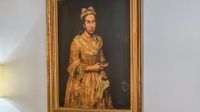In a saga that intertwines the shadows of World War II with the modern hunt for stolen art, Argentine authorities have placed Patricia Kadgien, daughter of a notorious Nazi fugitive, and her husband, Juan Carlos Cortegoso, under house arrest in Mar del Plata. The move, announced Tuesday, September 2, 2025, comes as police intensify their search for an 18th-century Italian painting looted from a Jewish art dealer during the Nazi regime—a painting that recently surfaced in the most unlikely of places: a real estate listing.
The painting in question, “Portrait of a Lady” by Giuseppe Ghislandi (also known as Fra Galgario), vanished for 80 years after being stolen by Hermann Göring, Adolf Hitler’s right-hand man and an infamous art plunderer. Göring’s haul included more than 1,000 works seized from prominent Dutch-Jewish dealer Jacques Goudstikker, whose family has spent decades trying to reclaim their lost legacy. According to the Associated Press, the painting was listed as missing in both international and Dutch databases of Nazi-confiscated works.
The extraordinary twist in this tale arrived last month when Dutch journalists from Algemeen Dagblad spotted the elusive portrait hanging above a green couch in Patricia Kadgien’s living room. The image appeared in a publicly available real estate advertisement for Kadgien’s Mar del Plata property, instantly igniting excitement among art historians and Goudstikker’s heirs. But as quickly as the painting reappeared, it vanished once more. By the time Argentine police raided the home on August 26, 2025, the portrait had been replaced with a tapestry of a horse—a substitution that raised more questions than it answered.
Authorities did not stop there. On Monday, September 1, 2025, under the direction of prosecutor Carlos Martínez and with the approval of federal judge Santiago Inchausti, police conducted further raids on two additional homes and an apartment linked to the Kadgien family. According to La Nacion and the Daily Mail, these searches yielded various prints, engravings, and two paintings possibly dating to the 1800s, as well as mobile phones, documents from the 1940s, and two unregistered firearms. Yet, the centerpiece of the investigation—“Portrait of a Lady”—remained missing.
Prosecutor Martínez accused Kadgien and Cortegoso of obstructing the investigation, ordering their house detention for at least 72 hours pending a court hearing. He told the Associated Press, “The couple has been accused of obstructing the investigation and ordered to remain at home while the search for the painting continues.” The Kadgien family’s defense team, meanwhile, offered to hand over the artwork but, as of the latest reports, had not followed through.
The story’s roots stretch back to the darkest days of the 20th century. Friedrich Kadgien, Patricia’s father, was a financial adviser to Göring and played a key role in the forced sale of art from Jewish galleries in Nazi-occupied Europe. After the war, Kadgien fled Europe with the help of Swiss lawyer Ernst Imfeld, eventually settling in Argentina, where he died in 1978. He was described by American interrogators as a “snake of the lowest sort,” notorious for his role in funding the Third Reich’s war effort through the theft of art and diamonds from Jewish dealers in the Netherlands, as reported by the Daily Mail.
Argentina, under Juan Perón’s regime, became a haven for thousands of Nazi fugitives after World War II, including some of the most infamous war criminals. Kadgien’s escape and subsequent success as a businessman in South America is a testament to the tangled legacies of postwar migration and impunity. Among his alleged activities was the sale of weapons to the Brazilian military junta, further complicating his legacy.
The painting that triggered the current legal and ethical standoff—“Portrait of a Lady”—is more than just a beautiful Baroque artifact. It is a symbol of the systematic looting that devastated families like the Goudstikkers. Jacques Goudstikker, a successful art dealer in Amsterdam, helped fellow Jews flee the Nazis before his own ill-fated attempt to escape. He died in 1940 at just 42, after falling into the hold of a ship while fleeing to Britain. His “little black book” of inventory, discovered by his wife Desi and son Edo, became a crucial record in the decades-long quest to recover his stolen collection.
Goudstikker’s heirs, particularly his daughter-in-law and only surviving heir, 81-year-old Marei von Saher, have been relentless in their pursuit. “My search for the artworks owned by my father-in-law Jacques Goudstikker started at the end of the 90s, and I won’t give up,” von Saher told Algemeen Dagblad. “My family aims to bring back every single artwork robbed from Jacques’s collection and restore his legacy.”
Recovery efforts have yielded some success: more than 200 pieces from Goudstikker’s collection were returned in the early 2000s. Yet many, including “Portrait of a Lady,” remained lost—until its chance appearance in Argentina. The case has reignited international debates over restitution, ownership, and the statute of limitations. Kadgien’s defense claims that, due to the time elapsed and Argentine law, the painting now belongs to their family. They have proposed that the artwork be placed in the custody of Argentine courts until legal ownership is determined, a move that has not satisfied Goudstikker’s heirs or international observers.
The case has also exposed the broader challenges of tracking Nazi-looted art. According to the New York Daily News, investigators seized documents and artifacts that could shed light on the fate of other missing works, including a painting by 17th-century Dutch artist Abraham Mignon, reportedly seen in a photo on a family member’s social media page.
The international art world and Holocaust restitution advocates are watching closely. With no time limits on possible charges due to the painting’s connection to the Holocaust—the worst genocide in human history—the legal battle is likely to continue. The story of “Portrait of a Lady” is far from over; for now, it remains a poignant reminder of the unfinished business left by history’s darkest chapter.
As the investigation unfolds and the search for the missing masterpiece continues, families, historians, and authorities alike are left to grapple with the enduring impact of art theft, memory, and justice.


